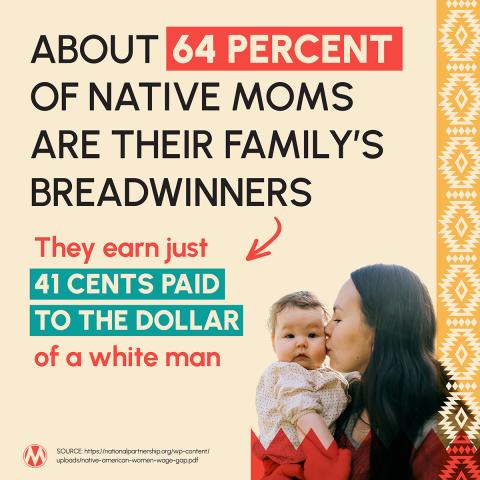
Join the Fight: End Pay Inequality on Native Women’s Equal Pay Day
The shutdown may have ended, but the impact it made on families is still very real. While leaders may claim business-as-casual, we know better. We know who felt the ripple effects the most: Caregivers, essential workers, moms, and women.
Specifically, Native American women, who have carried the weight of it, and now helping communities get back on their feet. November 18th was Native Women’s Equal Pay Day and a moment to acknowledge one of the widest pay disparities they face and the long recovery road ahead post-shutdown.
Native women are and have always been on the frontlines of our country’s economic struggles. So when events like a government shutdown happen and programs like SNAP and healthcare benefits are cut, it’s Native women who feel the impact the most. It may take some Native families years to recoup lost earnings and regain financial stability compared to families that earn more simply because of their racial identity and sex.
Here are the facts:
-
On average, Native women earn only 58 cents for every $1 paid to white men working part-time, full-time, and part year. [1]
-
About 64 percent of Native moms are their family breadwinners and they earn just 41 cents paid to the dollar of a white man. [2]
-
Native women with a professional degree stand to lose nearly $3 million to the wage gap over a 40-year career.
-
Native women with a bachelor’s degree, master’s degree, or doctorate degree stand to lose over $1.3 million to the wage gap over a 40-year career. [3]
Overall, Native American women lose almost $63.5 billion to the wage gap every year. And because Native identity is deeply rooted in culture, community, and ancestry, it's critical to honor its complexity, rather than simplify it into a single category. Meaning, the wage gaps only widen as the data disaggregates into the hundreds of Native tribes.
It’s also National Native American Heritage Month. A time for us to remember and honor who Native American women were and still are; leaders, providers, and protectors. Women who, despite forced displacement, genocide, sexual violence, abuse, and exclusion from land and labor rights, still manage entire communities and families. Native women cannot be erased, regardless of what history may have sold us. They are here, more resilient than ever, yet still underpaid and undervalued for their labor.
As Native women continue to carry families and communities through the residual effects of the recent government shutdown, food scarcity and health care crisis, it is up to all of us to ensure their work and contributions are recognized and their pay is fair.
- Have you or someone you love faced workplace discrimination or unfair pay? Sharing personal stories with our lawmakers is a powerful tool in the fight against discriminatory wage gaps! Tell us about your experience!
References:
[1] “Native Women’s Equal Pay Day”
[2] “Native American Women and the Wage Gap”
[3] “Native Women Lose More Than $1.2 Million to the Racist and Sexist Wage Gap Over a 40-Year Career”



The views and opinions expressed in this post are those of the author(s) and do not necessarily reflect those of MomsRising.org.
MomsRising.org strongly encourages our readers to post comments in response to blog posts. We value diversity of opinions and perspectives. Our goals for this space are to be educational, thought-provoking, and respectful. So we actively moderate comments and we reserve the right to edit or remove comments that undermine these goals. Thanks!